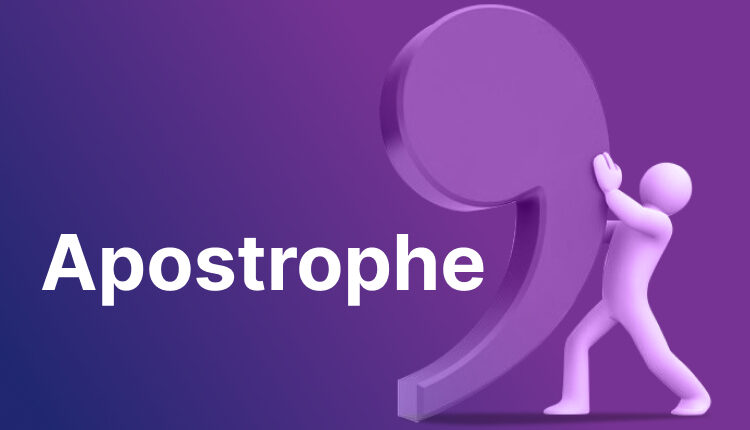Apostrophes are probably one of the most abused punctuation marks, but an apostrophe is crucial to the effectiveness of our writing. Such tiny marks can change the sentences’ meaning and give a light to the words relationship. Using an apostrophe while composing an email or writing a report, or even while sending a text to a friend can make the difference in how well you convey what you want to say.
Dive with us as we explain everything you want to know about the apostrophe-from definitions, to when and how to use it in contractions and possessives-get ready to strengthen your grammar and swell with pride in every written word!
Apostrophe Definition
An apostrophe is a punctuation mark primarily used to indicate possession or omission of letters in contractions. It reads ‘.
An apostrophe can indicate possession: Sarah’s book. It can indicate missing letters in contractions: don’t for do not. It is a vital tool whose misuse can obscure clarity and precision in your writing. Each use has a particular purpose that supports the meaning.
The apostrophe with other punctuation
An apostrophe often shows up with other punctuation marks, and it really brings a great deal of complexity to writing. For example, quotation marks often have to be used together with apostrophes: in this case, the apostrophe belongs to the quotation mark if it is part of the quoted phrase.
Consider this example: She said, “That’s my favorite book.” The placement clarifies ownership while still readable. In American English, commas or periods must be placed inside quotation marks, each time these punctuation marks are necessary, in order to maintain consistency and clarity in your writing.
Examples of Apostrophe in a Sentence
Apostrophes clarify meaning. For instance, “Sarah’s book” signifies that the book is Sarah’s; here the apostrophe is employed for expressing possession.
Again, there is another type that is shortened into a word, such as “don’t,” which merely is a shortened version of “do not.” These applications guarantee a lesser complexity in communication without compromising meaning. An apostrophe can even transform the meaning in writing dramatically with tiny marks.
How to Use Apostrophes: Rules and Examples?
An apostrophe is used for clarity in writing. It is primarily used to indicate ownership, such as in phrases like “Sarah’s book” or “the dog’s leash.” What it does is it denotes that something belongs to someone.
They are also employed to form contractions. For example, “do not” is shortened to “don’t,” and “it is” becomes “it’s.” The correct placement of an apostrophe will allow you to get across your meaning. Incorrect placement can result in misinterpretation of what you write.
Use of the Apostrophe: Contraction and elision
Apostrophes are to be used in forming contractions, which are only a combination of two words taken together. For instance, “do not” would become “don’t,” “you are” “you’re.” The writing seems fluid as well as conversational.
Apart from showing contractions, apostrophes are also applied to indicate omissions of letters or numbers. For instance, an apostrophe is applied in “rock ‘n’ roll” that omits the letter ‘a’ in “and.” Such applications are clearer and do not make language sound stilted.
Apostrophes and possessive nouns
Apostrophes can indicate possession. To indicate that something belongs to someone, simply add an apostrophe plus an “s.” For example, “the dog’s leash” lets us know the leash is the dog’s.
If the noun is plural and ends in “s,” you simply put the apostrophe after the “s.” So, for example, “the teachers’ lounge” refers to a lounge that serves several teachers. With this rule under your belt, you will be able to make more lucid writing.
Apostrophes and joint possession
If more than two people own something, then the apostrophe follows the last name. So you would write “Jack and Jill’s house” since both Jack and Jill own it.
If they have different things, you add an apostrophe after both names: “Jack’s and Jill’s bicycles.” This word shows that one bike is Jack’s and the other is Jill’s. Shared ownership helps clarify owning something shared and something individualized in the written word.
Apostrophes and Plurals
Apostrophes are often used incorrectly to pluralize. That’s incorrect; an apostrophe should not be added to a regular plural noun. For example, you would write “apples,” not “apple’s.”
However, there are exceptions for names, acronyms, or symbols where it is necessary to have clarity. For instance: “There are two A’s in ‘banana’.” Here, the apostrophe is used to show which letter is being referred to instead of making the word plural. Plus, never forget that you are considering context when you use them with plurals!
Apostrophes and surrounding punctuation
The good thing about apostrophes is that one must always consider the space around them. For example, if one has a quotation, then place the apostrophe appropriately within the quote marks.
Example: “Jessica’s book,” he said, “is fascinating.” One can see how the placement was clear and effective. Misplacement of an apostrophe often causes confusion in meaning. Double-check your sentences for the clarity of meaning even when other punctuation marks are present so that your writing will look smooth.
When to refer to a style guide
When writing, the uniformity of punctuation use needs to be upheld. Style guides are always there to guide both the writer and the editor. They define all details regarding the proper use of an apostrophe among other grammatical elements.
If you are writing academic papers, professional documents, or publishing content that requires accuracy, you should reference a style guide. Apostrophes are used differently in different disciplines. Becoming familiar with the guidelines will clean up your writing and make it look more professional.
In all cases, make sure to be right for your reader. If it’s AP Stylebook or Chicago Manual of Style, then there’s a whole system as to whether they use the apostrophe at all.

